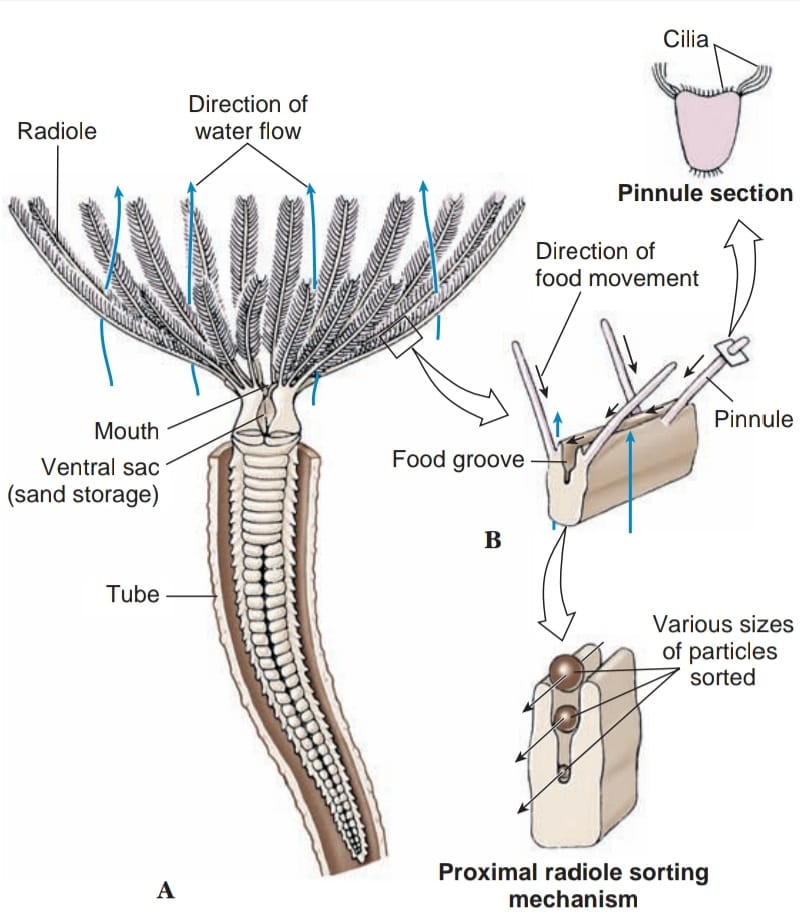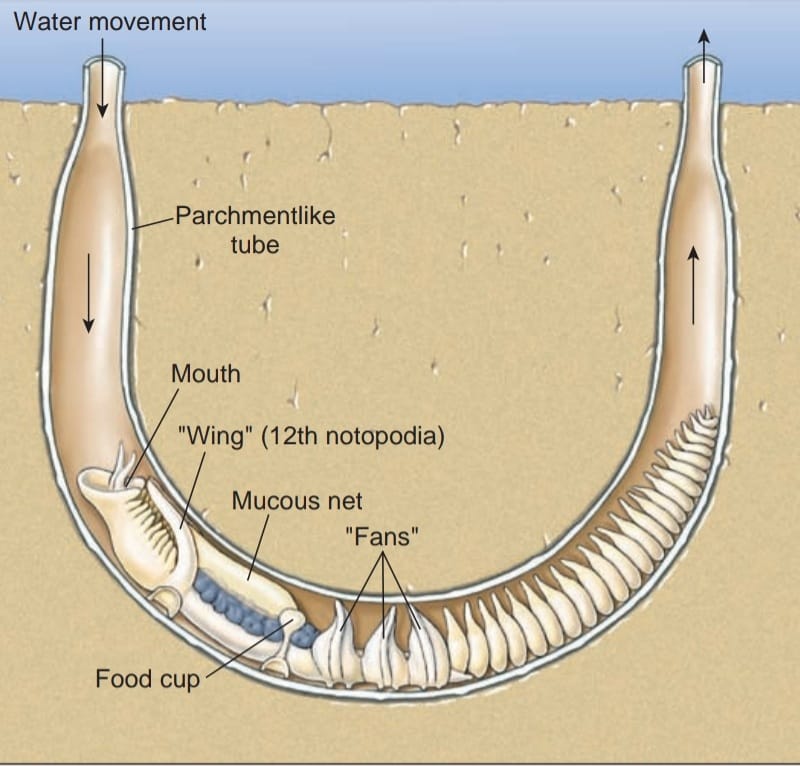Clam Worms: Nereis Clam worms, or sand worms as they are sometimes called, are errant polychaetes that live in mucous-lined burrows in or near low tide. Sometimes they are found in temporary hiding places, such as under stones, where they stay with their bodies covered and their heads protruding. They are most active at night, when they wiggle out of their hiding places and swim or crawl over the sand in search of food. The body, containing about 200 segments, may grow to 30 or 40 cm in length. The head is composed of a prostomium and a peristomium. The prostomium bears a pair of stubby palps, sensitive to touch and taste; a pair of short sensory tentacles; and two pairs of small dorsal eyes that are light sensitive. The peristomium bears the ventral mouth, a pair of chitinous jaws, and four pairs of sensory tentacles.

External structure. C, Posterior end. D, Generalized transverse section through region of the intestine. E, In this photo of a live N. diversicolor, note the well-defined segments, the lobed parapodia, and the prostomium with tentacles.
Each parapodium has two lobes: a dorsal notopodium and a ventral neuropodium that bear setae with many blood vessels. Parapodia are used for both creeping and swimming and are controlled by oblique muscles that run from the midventral line to the parapodia in each segment. The worm swims by lateral undulatory movement of the body. It can dart through the water with considerable speed. These undulatory movements can also be used to suck water into or pump it out of the burrow.
Clam worms feed on small animals, other worms, and a variety of larval forms. They seize food with their chitinous jaws, which they protrude through the mouth when they evert their pharynx. Food is swallowed as the worm withdraws its pharynx. Movement of food through the alimentary canal is by peristalsis.
Scale Worms Scale worms are members of the family Polynoidae (Gr. Polynoe, daughter of Nereus and Doris, a sea god and goddess), one of the most diverse, abundant, and widespread of polychaete families. Their flattened bodies are covered with broad scales, modified from dorsal parts of the parapodia. Most species are of modest size, but some are enormous (up to 190 mm long and 100 mm wide). They are carnivorous and eat a wide variety of animals. Many are commensal, living in burrows of other polychaetes or in association with cnidarians, molluscs, or echinoderms.

the tubes of Urechis.
Fireworms Hermodice carunculata Gr. herma, reef, dex, a worm found in wood and related species are called fireworms because their hollow, brittle setae contain a poisonous secretion. The setae puncture a hand that touches them, and then break off in the wound to cause skin irritation. Fireworms feed on corals, gorgonians, and other cnidarians.

Tubeworms
Polychaete tube-dwellers secrete many types of tubes. Some are parchmentlike or leathery some are firm, calcareous tubes attached to rocks or other surfaces and some are simply grains of sand or bits of shell or seaweed cemented together with mucous secretions. Many species burrow in sand or mud, lining their burrows with mucus .


Most sedentary tube and burrow dwellers are particle feeders, using cilia or mucus to obtain food, typically plankton and detritus. Some deposit feeders, like Amphitrite, protrude their heads above the mud and extend long tentacles over the surface to find food. Cilia and mucus on the tentacles entrap particles found on the sea bottom and move them toward the mouth. Lugworms, Arenicola, use an interesting combination of suspension and deposit feeding. They live in a U-shaped burrow through which, by peristaltic movements, they cause water to flow. Food particles are trapped by the sand at the front of the burrow, and Arenicola then ingests the food-laden sand.

Fanworms, or “featherduster” worms, are beautiful tubeworms, fascinating to watch as they emerge from their secreted tubes and unfurl their lovely tentacular crowns to feed. A slight disturbance, sometimes even a passing shadow, causes them to duck back quickly into the safety of the homes. Food drawn to the feathery arms, or radioles, by ciliary action is trapped in mucus and carried down ciliated food grooves to the mouth. Particles too large for the food grooves pass along the margins of the food grooves and fall away before they reach the mouth. Only small particles of food enter the mouth; sand grains are stored in a sac to be used later in enlarging the tube.


The parchment worm, Chaetopterus (Gr. chaite¯, long hair, + pteron, wing), feeds on suspended particles by an entirely different mechanism. It lives in a U-shaped, parchmentlike tube buried, except for the tapered ends, in sand or mud along the shore. The worm attaches to the side of the tube by ventral suckers. Fans (modified parapodia on segments 14 to 16) pump water through the tube by rhythmical movements. A pair of enlarged parapodia on segment 12 secretes a long mucous net that reaches back to a small food cup just in front of the fans. All water passing through the tube is filtered through this mucous net, the end of which is rolled into a ball by cilia in the cup. When the ball is about the size of a BB shot (about 3 mm diameter), the fans stop beating and the ball of food and mucus is rolled forward by ciliary action to the mouth and swallowed.
Useful External Links
- Polychaete chaetae: Function, fossils, and phylogeny by Sarah Woodin
- Polytraits: A database on biological traits of marine polychaetes by Lucia Fanini
- Diversity and Distribution of Polychaetes (Annelida: Polychaeta) Along Maharashtra Coast, India by R.M Sharma


